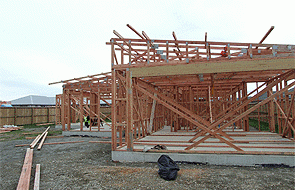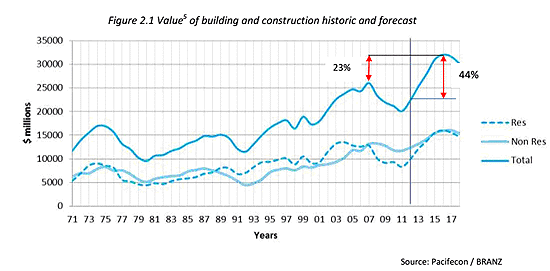

The rapid deterioration in the export log market continued in July with export log prices down an average of $12/JAS m3.
The export “A” grade price has fallen $62/JAS m3 in 3.5 months, a fall of 44% from its March 2014 high.
Many domestic prices were also renegotiated for the third quarter of 2014. Some regions experienced sharp down-turns (e.g. Northland and Central North Island) and in others prices remained steady (e.g. Canterbury and Nelson).
Overall the PF Olsen log price index fell $8 to $87.
Since the recent high of $117 in March 2014, this index has fallen 26% in four months.
Export Log Market
The export log market continued its steep downward momentum into July. CFR price (the US$ price of logs landed at sales ports) has fallen further due to stubbornly high log stocks in China.
In addition, a three percent appreciation of the NZ$ in June adversely impacted on NZ$ at-wharf-gate prices.
There was a partial offset in slightly more favourable ocean freight rates as Handy-size dry-bulk vessel charter rates eased. The net effect, however, was falls of $8-$15/JAS m3 in export log prices (depending on grade and port).
How do export log prices now look in comparison to the past?
The NZ$ at-wharf-gate price of export “A” grade in July is around $87/JAS m3 (depending on port). This price level was last seen in December 2004, March 2006, December 2007 and September 2009. So we are not in brand new territory.
However, July’s “A” grade price is 13% below the 10-year average of $100 (and that’s in nominal terms). The other difference is that harvest and haul costs have increased steadily over the past 10 years, especially with the increase in cable hauler systems and harvesting of more remote forests.
This means that the price drops we have seen over the past four months are putting many harvesting jobs into a loss-making situation, something forest owners are very keen to avoid.
Credit restrictions in China have meant that log purchasers have found it difficult to get trade credit.
This is a downward spiral as entities that open letters of credit for purchasers see increased risk with the falling log prices. They, in turn, require a bigger down-payment to secure the letter of credit.
Purchasers facing large losses and limited cash flow from their devaluing log inventory cannot afford the larger down-payments and can’t open letters of credit.
Consequently demand for logs reduces and prices fall further. This has exacerbated the severity of the market downturn.
The chart below shows Chinese imports of logs from four significant log suppliers. For the period of January to May volume has increased from 8.8 million m3 in 2009 to 15.1 million m3 in 2014, an increase of 6.8 million m3 or 82% in just five years.
During these months in 2014, Russia reversed its downward supply trend and actually supplied 700,000 m3 more volume than in the 2013 period.
This has been a response to the high log prices prevalent in the price upswing and had a material impact on the build-up of log stocks in China.
Log stocks in China remain above 4 million m3. Just as the increase in log supply to China has taken years to build up, so too a reduction in supply takes time.
This is due to logs in the supply chain and the lag effect of responding to demand and price. It takes months for logs that are scheduled for harvesting to be felled, extracted, hauled to port, loaded on vessels and shipped to China.
The reduction in supply will happen because at current log prices most harvesting is running at a loss and is not financially sustainable. Russia’s harvesting, for example, is largely confined to very high cost areas and needs high log prices to be viable. The same can be said for most of the Pacific North West, Australian and New Zealand supply.

Source: Pacific Forest Products Ltd
Korea is still providing good sales options, especially for shippers without a fumigated or debarked deck cargo. This market is moving down with the Chinese market, but tending to lag.
India has provided some more attractive sales for lower quality grades (KI and KIS) which have been particularly hard hit by in the China market. However, a surge in shipments into this relatively small market has resulted in large price reductions. This could prove problematic to late arrivals without clean letters of credit if purchasers push for lower-than-contracted prices to meet the market.
So what about the demand side?
Will it be high enough to stimulate a near-term recovery in the log market or will there be a prolonged downturn?
As mentioned previously in this column, the Chinese government wants to see a stable property market, without excessive inflation and speculation.
While some property developers will fail due to reduced demand for housing, this is acceptable to the Chinese government in order to quell the rampant speculation.
Recently the government has responded to the downturn by reducing the banking reserve ratio and freeing up credit. It has also announced increases in infrastructure spending and 119 billion yuan (19 billion US$) on slum renovation and affordable housing this year, up 18 percent on 2013.
The sentiment among market commentators is mixed. The more pessimistic are expecting further price decreases and no meaningful recovery until at least the beginning of next year. The more optimistic are calling a July low point and forecasting price increases commencing in August or September – it is worthwhile noting that two large exporters have consistently been of this view through this entire down-turn.
While the statistics and past price trends all point to a recover in the market, the big question is “when” and “how quickly”. Hopefully by the end of July, these will become more apparent.
Domestic Log Market
The receiver appointed to Thames Timber has announced a sale of the business to Profiles Wood Products Ltd, with settlement to occur on 18 July 2014. According to the receivers, KordaMentha, the purchaser will integrate the Thames Timber’s greenmill and drymill operations into its existing business which consists of several sawmilling, timber drying and wood processing operations in the Central North Island.
Initially the integration is expected to reduce operations from two shifts to one, with some redundancies for the workforce. Despite the reduction in shifts, the new ownership provides confidence for this operation continuing, and perhaps expanding in the future.
A busy round of negotiations for log supply in the third quarter of 2014 occurred with the backdrop of weakness in the export log market.
In regions where price parity to export has been a significant price driver, domestic prices have fallen considerably, especially of the lower quality export-oriented grades. In other regions, where pricing and supply levels are more driven by the domestic market, price falls were much lower, or prices remained steady.
In Canterbury, for example, the final stages of salvage logging of last year’s windthrow and lower harvesting activity due to the export market downturn has resulted in relatively lean supplies of sought-after domestic grades. This is at a time of strong demand for structural logs to manufacture wood products for the buoyant property construction (reconstruction) market.
Pacificon (NZ) Ltd in conjunction with BRANZ has forecast unprecedented demand for building and construction over the next five years in New Zealand. This is primarily driven by residential housing growth in Auckland and the Canterbury rebuild.
In addition, there is growth in major road construction projects driving non-residential demand.
The forecast peak of $32 billion of expenditure in 2016 is 23% higher than the prior peak of $26 billion in 2007 (see chart below). This bodes well for demand for wood products domestically. However, it is also a driver of the Reserve Bank hiking interest rates to fend off inflation.
This puts upward pressure on the value of the NZ$ as investors chase higher yields. This, in turn, adversely impacts on export-oriented domestic log processors as the high NZ$ reduces the returns from wood products exports.

The housing recovery in the US is building momentum again after pulling back late last year and early this year. Housing starts in April were at an annualised level of 1.08 million units. The US federal housing agency has announced a shift in focus from reducing exposure to mortgages to making more credit available. This is likely to drive more home purchases and further building in the US. This trend will simultaneously increase demand for imported wood products and constrain export of wood products which might otherwise compete with New Zealand wood products in Asian markets.
The PF Olsen log price index fell $8 to $87. Since the recent high of $117 in March 2014, this index has fallen 26% in four months.
PF Olsen Log Price Index

Basis of Index: This Index is based on prices in the table below weighted in proportions that represent a broad average of log grades produced from a typical pruned forest with an approximate mix of 40% domestic and 60% export supply.
Indicative Average Current Log Prices
| Log Grade | $/tonne at mill | $/JAS m3 at wharf |
| Pruned (P40) | 145 | 130 |
| Structural (S30) | 101 | |
| Structural (S20) | 91 | |
| Export A | 76 | |
| Export K | 68 | |
| Export KI | 58 | |
| Pulp | 48 |
Note: Actual prices will vary according to regional supply/demand balances, varying cost structures and grade variation. These prices should be used as a guide only and specific advice sought for individual forests.
---------------------------------------------------------------
This article is reproduced from PF Olsen's Wood Matters, with permission.
We welcome your comments below. If you are not already registered, please register to comment
Remember we welcome robust, respectful and insightful debate. We don't welcome abusive or defamatory comments and will de-register those repeatedly making such comments. Our current comment policy is here.